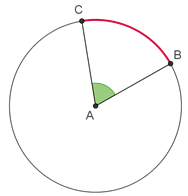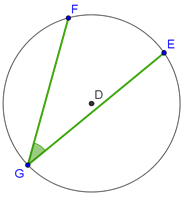
In a circle, there are two ways to quantify arcs of the circle itself.

Arc length refers to the linear distance between two points along the circle. Arc length is usually measured in standard units of length, such as inches or centimeters. In the figure at the right, the length of arc BC would be the distance you could measure with a ruler if you were to cut out arc BC from the circle and straighten it out into a line segment.
Arc measure refers to the angular distance, or portion of the angular measure of a circle, that the arc between the two points along the circle includes. Arc measure is usually measured in degrees, and is defined to be the same as the measure of the central angle containing the two endpoints of the arc. In the figure, the arc measure of arc BC is the same as the measure of central angle CAB, which is shaded in green. As with other angular measures, arc measure really is a measure of rotation from point B to point C about the center of the circle, point A.
Other terms that are important in this lesson include:

An inscribed angle is an angle whose vertex and other two endpoints all lie on the circle. In the figure at the right ∠FGE is an inscribed angle because its vertex, G, is a point on circle D. Points E and F are also points contained on circle D.
When an angle contains points that are on a circle, the angle is said to intercept the arc that lies in the interior region of the angle. In this figure, ∠FGE intercepts
 EF of circle D.
EF of circle D.